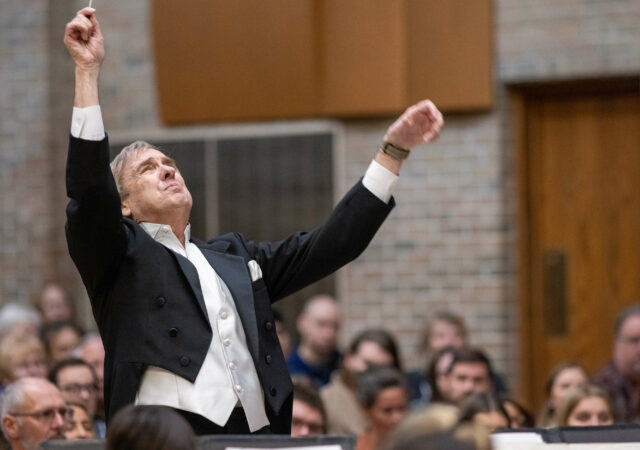
By Roy S. Askins
It’s no secret that institutions of higher education in The Lutheran Church—Missouri Synod (LCMS) have been a subject of much discussion and concern. Not only have three institutions of the Concordia University System (CUS) closed over the last seven years, but some of the current institutions face concerns over rising costs and potential future enrollment declines, causing the shuttering of programs and reductions in faculty and staff.
“We were predicted to lose, in the United States, many smaller private colleges and universities, and that prediction came true,” said the Rev. Dr. Matthew C. Harrison, LCMS president. “A new study predicts the continued closure of small religious schools, and the demographics that have forced that [to happen] have also greatly affected the Missouri Synod — as we all know, very painfully.” A recent report stated that 99 colleges closed between the 2022–2023 and 2023–2024 academic years.
The closure of CUS institutions affects the church in broad ways. Fewer schools means fewer opportunities to train pastors and other church workers. But it also means fewer options for Lutheran parents who want to send their child to an institution that trains up the laity of the LCMS in godly vocations while encouraging and fostering the faith these parents have inculcated in their children.
Retention
A 2019 LifeWay study found that 66% of Protestant young adults dropped out of regular church attendance in their young adult years for at least a year. It’s seemingly connected to college: 34% confirmed that this happened because they moved to college. In truth, a general apathy toward the faith seems to be at the heart of much of the issue. This lends credence to the argument that children who aren’t attending church in college abandoned it as far back as grade school.
I suspect many LCMS parents are indeed concerned about the faith of their children. However, when it comes to choosing college, parents often seem to be choosing future career success over the long-term faith of their child. During vicarage, I served a campus ministry in an incredibly Lutheran part of the country. That year, we did not receive a single phone call from a parent asking for us to provide for the spiritual care of that child.
The simple truth is this: The majority of institutions of higher learning in the United States have become hostile to the faith. If you are truly concerned with the faith of your child, there are basically two options: 1) a university situated near a faithful church and/or campus ministry program, or 2) one of the Synod’s Concordia universities.
As a parent who will soon be looking for a university for my child to attend, I am deeply concerned with the future of these institutions. To that end, I dug into the current trends sweeping through American higher education and how our CUS schools are adapting to these trends to ensure they will weather the next half century. I interviewed all the presidents of our Concordia universities and spoke with the leadership at the CUS. I also spoke with leadership in the LCMS.
Here’s what I learned: The pressures on our institutions are sinister and real. They have rocky years ahead of them. At the same time, they are all fully committed to a robust Lutheran identity and creative ways to keep these institutions alive for future generations. This multi-article series will explore issues facing all institutions of higher education, but especially our Concordia universities, starting with the major trends creating headwinds in higher education and the way each university is addressing them.
Falling enrollment
The most obvious trend affecting higher education in the U.S. is declining enrollment. College enrollment is down 8.5% from 2010 and is continuing to decline about 1.5% per year. The decline is more dramatic among men than women. The year-on-year decline is not expected to change significantly until 2037.
This school year was particularly bad. The enrollment of 18-year-old freshmen dropped 5%. Institutions serving low-income students saw the most dramatic decline, up to 10% in enrollment reductions.
Declining enrollment results from a number of causes, and some of them are trends in higher education in their own right. The issues caused by declining enrollment aren’t always fixed by simply boosting enrollment; a number of small schools closed over the last decade despite increases in enrollment because educating undergraduate students is so expensive.
Demographic cliff
The most obvious driver of declining enrollment is the demographic cliff. The years 2007–2009 were particularly bad for babies in the U.S. Birthrates dropped 4%, a decrease not seen since the 1960s and 1970s. Birth rates declined in every age group of mothers except those age 40–44. Much of this decline in 2007–2009 is attributed to the Great Recession. However, the birthrate hasn’t corrected. Since 2007, the U.S. birthrate has declined 17%.
Now, 17 years later, fewer students are available in the U.S. to enroll in colleges and universities. The U.S. supply of colleges exceeds demand, requiring colleges to compete for an ever-decreasing pool of students.
Rising costs
Increasing supply and decreasing demand makes higher education a buyer’s market. Up to this point, the rising costs of education have passed on to students at a rate that far outpaces inflation. In inflation-adjusted numbers, tuition and fees at private universities have increased 41%. Out-of-state fees and tuition increased 32% at public universities, and in-state tuition increased 45%. To put that in perspective, in 2005, public four-year colleges cost, on average, $5,491 per year. Today, average in-state tuition costs $11,610.
Not only have annual costs increased, but the time it takes to complete a degree has also increased. The National Center for Education Statistics reported that 64% of graduates in 2020 had been working on the degree for six years. Students are paying more and taking longer to complete their degrees.
The transition to a buyer’s market has left parents and students evaluating the return on investment in a college degree. When they see debt-laden graduates struggling to find employment while blue-collar workers obtain gainful employment with little to no educational debt, it disincentivizes a four-year degree. This is sad news, especially since a bachelor’s degree, particularly in STEM fields, still generally correlates with greater economic stability.
Rising costs are also affecting the institutions as they face the effects of paying faculty and staff at inflationary rates. Paired with a “deteriorating credit environment” as reported by Fitch Ratings, it could spell financial disaster for many smaller institutions in particular.
The ‘Great Awokening’
Parents are also concerned about what their children are being taught. As noted in the beginning of this article, young college students are more apt to stop attending church in college. It’s not entirely a result of a secularizing influence, but it’s also clearly the case that students are graduating with significantly different views than Christian parents want.
Dr. Russell Dawn, president of Concordia University Chicago (CUC), River Forest, Ill., identifies this “great awokening” and the concomitant cultural decay as, at its root, a rejection of “transcendent truth”: “It goes back to specifically a rejection of Christianity, but also rejecting ideas of natural law and the virtues, of human nature and the nature of the world made by our Creator,” Dawn said. “We’re seeing the bitter fruit of literally centuries of rejecting transcendent truth, specifically biblical truth.”
While some might claim the Great Awokening of American college youth is on the decline, they can’t do so without acknowledging the overwhelming prevalence of anti-Christian perspectives in colleges. And even if they are declining, it does nothing to assuage the concerns of Christian parents. It’s one reason Christian institutions that proudly cling to their identity aren’t facing the same level of enrollment declines.
Regulation and review
Government regulation at all levels is changing the face of higher education as well. While it appears that the Trump administration is overturning the DEI and LGBTQ agendas driving the previous administration, it doesn’t mean regulation is no longer present.
One such potential regulation is the College Cost Reduction Act. The bill attempts to stop colleges from dispensing degrees that do not pay out for students, potentially requiring institutions to take on some of the student debt of less desirable degrees. It also seeks to make the cost of college more transparent and adjusted per student. The act is still in Congress for the time being, but if passed, it will have broad repercussions for schools.
“On the one hand, it makes sense,” said the Rev. Dr. Brian Friedrich, president of Concordia University, St. Paul (CSP), St. Paul, Minn., “because the federal government and state government pour lots of money into higher education.” This means regulation for schools that take government money: “Higher education does not get a blank check,” he said. “They’re going to have a sharper eye and focus on holding institutions of higher education accountable.”
Flexible options
Now, four to five years after the COVID pandemic, students who spent large portions of high school in virtual learning environments are seeking similarly flexible options for college education. Often, these are hybrid learning environments, where some classes are in person and others online.
“Sometimes students want to take a full 16-week semester class; other times they’d like to compress a course into eight weeks,” Friedrich said. Some of this is a desire to be able to work while at school; other times it’s to accommodate intense sports schedules. “If the bulk of a student-athlete’s competition is in the second half of the first semester and the first half of the second semester, they may want to take a class they can complete in eight weeks,” Friedrich explained.
On the other hand, it’s also a reality that many students are simply more comfortable in online education environments. “The surprise is that there is an increasing demand among 18- to 22-year-olds. Through COVID, they did [high] school behind a screen, and they’re comfortable with that, living at home,” Dawn said. “They find it to fit them the best.”
There are concerns about the quality of higher education done primarily online; however, some studies are showing that when done properly, online education can be as effective as in-person and residential training for certain types of programs. Nothing beats in-person education for forming students, but online programs can certainly provide opportunities for learning.
Competitive environment
As a result of the trends above, the environment in which American universities now find themselves is highly competitive. The same number of colleges chasing fewer students in a variety of flexible options means that colleges are operating less like pure institutions of higher learning and more like businesses. “We are businesses,” said Dr. Erik Ankerberg, president of Concordia University Wisconsin and Ann Arbor. “As much as it’s essential that we talk about mission, faithfulness and churchly things, there is also an equally important reality that we are fragile financially, and we can’t carry out our mission without the [necessary] resources.”
Universities are now concerned with rankings — not only the ranking of the quality of the education they provide, but also rankings of their financial viability. Parents and students are seeking institutions that will provide long-term benefits to their children, and institutions that might appear to be on the edge of financial viability raise red flags and concerns about whether the student will graduate or whether the degree will be as valuable if the institution shutters operations.
For the Concordias, financial viability is a great concern. For example, a recent article by Forbes graded the financial health of institutions across the U.S., and the Concordias came in particularly low. Potential students and parents glancing at the report will doubtless have concerns. A deeper look, however, reveals that institutions with larger endowments received higher grades, while those with higher dependence on tuition dollars received lower grades. For the Concordias — institutions originally founded for the preparation of church workers — endowments are growing but not at the same level as other institutions.
Finally, schools that gave too much financial aid were also penalized; once again, for the CUS schools, a key part of their work is training church workers at low or no-cost education. This means a lot of financial aid. Regardless, the priorities of the institution do not change the grade, meaning that the Concordias must work even harder to assure parents and students of their ongoing financial viability.
A return to classical education
Another marked trend, especially in LCMS circles, is a return to liberal arts and/or the classical education model. “The whole classical education trend [is] a hot trend with families with children that do a lot of homeschooling,” said the Rev. Dr. Douglas Spittel, vice-president of the CUS. “A lot of classical education schools have opened up in the last 10–15 years and are doing quite well.”
The interest in a traditional liberal arts degree focusing on the primary texts of the Western tradition has grabbed religious and non-religious parents, students and philanthropists alike. These schools focus on reading the classic texts of Western culture and helping students engage with the ideas therein. As students work their way up through classical day schools and high schools, they are also looking for universities that will continue that program education to completion.
Declining enrollment in higher education is not a standalone trend. Rather, it’s tightly connected with increasing costs, declining trust in education, concerns over the return on investment, and a changing education environment. Generally, these trends are expected to affect small private universities located in the Midwest and the Eastern seaboard.
The institutions in the Concordia University System are gearing up to face these trends each in their own unique ways. In future installments of this series, I will share how each president is positioning the school he serves to address these trends.
Posted March 26, 2025





It would be beneficial to list the LCMS colleges that have closed in the past 7-10 years.
I’d like to see the list going all the way back to the 1950s. Colleges like Oakland, Winfield, and others could give a broader picture of the changes that have transpired over time.
Three Concordias in Bronx NY, Selma AL, & Portland OR.
Thank you for this concise “part one” article pertaining to higher education — at our colleges and universities in the LCMS and nationwide. It was extremely informative for me and helps me understand the challenges we face and the reason for declining enrollment. It all makes sense and I’m hopeful/prayerful we can meet the requirements for students wishing to enter into professional churchwork, providing them an excellent “on campus” opportunity as well as possible online classes. In-person classes provided me with interaction — not only with gifted faculty members but with fellow students, strengthening my relationship-building skills. I believe those skills helped me with my own leadership and relationships both in business and within the church at large.
I look forward to your continued commentary on the challenges we face in higher education.
Thank you! Let us know how we can help. My experience with campus ministry at a public university completely shaped my faith. Funding campus ministry as a mission is vital, in my opinion, in nurturing the faith of college students as well as helping to build leaders in the church. The group of students I attended with during my college years produced 3 LCMS Pastors. I, myself, though a public school teacher, have always been involved in the children’s ministry of our church.
I wish that the Concordia Universities would take on more of the STEM degrees. When I was searching for a University many years ago I noticed there were no opportunities for an engineering degree available through Concordia. I understand that this might be hard to implement, but was just making the point.
An interesting article. And yet Concordia Ann Arbor experienced an increase in enrollment and yet was abruptly, with no discussion or consideration of alternatives, “restructured” by the Board of Regents to exclude classes for future pastors and teachers. Not Lutheran enough? Money to be made through the sale of prime real estate? Baptisms of adults who had no home church? Not enough Lutheran “icons”? Just saying what I have heard and nothing to explain how this whole thing lines up with scripture which is what I have always thought to be the mark of Lutherism.
Leslie, thank you for your comment. Please stay tuned for an article about Concordia, Ann Arbor, later in this series.